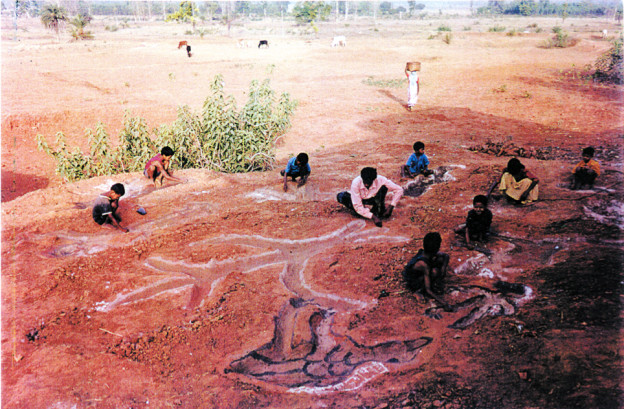Navjot Altaf is an artist living and working in Mumbai and Bastar. For the past two decades she has produced sculpture and video installations addressing violence in individual and collective memory in India and other parts of the world (e.g. the communal riots in Bombay in 1993 following the Babri Masjid demolition in Ayodhya in 1992-3 and attacks associated with the rise of right-wing fundamentalism in India) at museums and galleries in Mumbai, New Delhi, Fukuoka ,London, Liverpool/Bolton, Berlin, New York and other places.

Beginning in the early ‘90s she produced a series of cooperative works with composers, musicians, documentary filmmakers and craftspeople. These led her in turn to develop a series of interactive/collaborative projects in Indian villages, revolving around the design and creation of water pump sites and children’s temples (Pilla Gudis) in collaboration with Adivasi artists from Bastar, Chattisgarh in central India. As Altaf has written, “The Pilla Gudis emerged from the realization that village children had no space of their own where they could go to play or engage in other activities outside school hours. (They) are designed as meeting spaces in which young people could interact with each other and with community members with a knowledge of oral and artistic traditions in their village (as well as visiting and invited artists from throughout India). “Such interactions,” Altaf continues, can “encourage the young to think about different ways of knowing and modes of working, enabling them to draw nourishment and sustenance from difference and similarities. The . . .mainstream education system [in India] neutralizes cultural difference in the hope of creating a sense of ‘Unity in Diversity’ which affects student’s perception of culture.” The idea, Altaf notes, is to “encourage young minds to be able to question and take decisions, rather than merely receive. This will also help the artists engaged with the activities to free themselves from taking a stereotypical position of a teacher.”

Altaf’s water pump sites are also produced in collaboration with craftspeople and children: “Our concern of designing and transforming the sites is firstly to create drainage and to improve hygiene since Nagger Palika (the local municipality) does not provide this facility. Second, we want to design shelves for women to place their vessels on, to avoid weight on the bent leg before placing it on their head (according to doctors a particular bent leg posture harms the back over time). Thirdly, we hope to beautify the public sites where women, children, and men of all ages come for a mundane job like fetching water as many as ten times, a day for domestic or other usage. Seven local women artists and inhabitants, at different levels have participated in the process.”
“For us, organizing the art workshops for the young is as important as creating the sites (Pilla Gudis). It encourages a communication network between artists from different cultures and disciplines from within Bastar and outside and with and between the young. The plan is also to invite social and cultural volunteers, college students, teachers, workers, peasants, hawkers and others to participate. They can in many ways share their experiences of belonging to different cultural and economic backgrounds and how or whether they are knowingly dealing with the issue of migration in present times. The adivasi areas around Kondagaon,now part of a new state, Chattisgarh, are no longer remote. My Adivasi colleagues see themselves as interventionists in their own environment. The nature of their intervention, mine and ours together, perhaps can be known from the intentions of our concepts, questioning, and ways of carrying out the work at public sites. Process, though time consuming helps in learning about the subtle and complex ways of different local cultures.”

